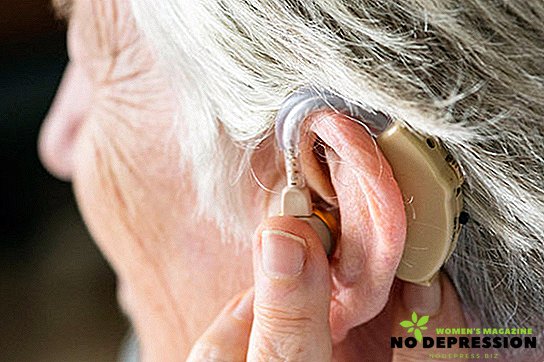With age, human health is deteriorating. Including the work of the organs of hearing. Most often hearing loss occurs in older people. Drug treatment does not always help. In this case, hearing aids can help older people. The main thing is to choose the right device, taking into account the characteristics and features.

Hearing Aid Tips
When choosing a hearing aid, you need to familiarize yourself with its characteristics, this will allow you to get the most optimal option.
Control type
Older people are hard enough to master modern technologies, because it is better to choose a device with electronic programming. In this case, the device will independently assess the human hearing ability, ensuring maximum audibility.
Volume control
If you purchased not electronic, but a handheld device, you should pay attention to the fact that the volume control should be as convenient as possible - large and noticeable.
Power supply
Older people will find it difficult to regularly change batteries, so it’s worth choosing devices that last long enough without changing the power source. There are devices that can work without interruption for three weeks (usually these are ear models), however, the power supply of the intra-channel devices last an average of about a week.
Power
With age, hearing decreases, so you should choose models that have a good supply of power.
Noise or whistle suppression
With the presence of suppression feedback function (noise) minimizes the risk of whistles, which can lead to discomfort. It is also worth remembering that the noise during the operation of the hearing aid impairs the sound quality. This not only causes discomfort, but can also cause headaches.
Indications and contraindications
 Hearing aids are designed for those who have hearing loss.
Hearing aids are designed for those who have hearing loss.
But people who additionally suffer from convulsive syndromes, epilepsy, and nervous diseases do not need to acquire devices.
It is also contraindicated to use intracanal devices for inflammation of the outer ear and auditory passages. The use of hearing aids for problems with motility can be problematic.
What types of devices exist
Before choosing a device, you should study what types there are, which will allow you to choose the most suitable option.
Depending on the degree of sound processing, they are:
- Digital. Common enough hearing aids. The main advantages include the fact that the devices distinguish between speech and external noise. Adapt to the setting, adapting sound settings; transmit speech and sounds without distortion.
- Analog. They are not able to distinguish between speech, amplify certain sounds. Hearing impairment is often observed during their prolonged use, because the technique enhances all sounds: both quiet and loud. The main advantage is low price.
Hearing aids are also distinguished by the method of installation.
Intraocular
They are placed in the auricle. The device compensates for average hearing loss. The advantages include:
- stealth;
- ease of use;
- the possibility of manufacturing individually for each person;
- high-quality sound transmission;
- no discomfort when wearing glasses, hats.
Also, devices are divided into the following types:
- Konha. Such devices occupy the entire area of the auricle. They are quite noticeable; they can cause discomfort when used.
- Semi-conch Such products have smaller sizes, are made strictly individually, therefore they are practically not noticeable and not noticeable, because they are ideally suited for the auricle. Compensates for any loss of sound.
- Miniature apparatus. It is placed inside the ear canal, it transmits sounds as clearly as possible, since it has the function of suppressing external noise.

Intra channel devices
They are installed deep into the auditory canal, so the hearing aid is practically invisible. Differs in the small sizes, it is made for each patient according to his anatomic features. Due to the presence of an integrated digital system, a clear sound is provided without any interference. True, the device is contraindicated in acute diseases of the hearing, with poor sensitivity of the fingers, when it is not possible to install the hearing aid yourself.

Deep hearing devices
Also made on the mold, set deep in the ear canals. Due to this, the quality of the transmitted sound is practically no different from the perception of sounds with a healthy ear. This is due to the fact that the drug is located very close to the eardrum.

Pocket product
Such models are not very popular because:
- have large sizes - you need to look for a place in your pocket or hang it in a belt;
- noticeable to others;
- inconvenient to use.
Such a product is perfect for older people who have problems with motor skills. In addition, this is a fairly inexpensive option - pocket hearing aids cost much less than other models.

BTE Devices
These products most often consist of parts such as a microphone (insert), located in the auricle, and the main part, which is located behind the ear. This drug is able to compensate for even severe hearing loss, but the downside is that the hearing aid will be noticeable to others.
Hearing Aid Rating - Specs and Prices
Before you go to the store, you should examine the products, the cost of hearing aids, features and characteristics.
Siemens (Siemens)
Attracts a wide range. In addition, the products of the German company Siemens offers extremely reliable and high-quality products with an adequate price. Hearing aids from this manufacturer are characterized by:
- exquisite design;
- ease of operation;
- small size;
- clarity of sound.
The cost of hearing aids depends on the type and model of the device. On average, intra-channel products are sold at prices ranging from 25 to 80 thousand rubles. BTE options can be purchased for 15-20 thousand rubles. Also on sale you can find similar devices of this company, the maximum cost of which is 15 thousand rubles.

Sonata
Zaunnye devices of this brand differ in affordable cost, since the Sonata is a device of domestic production. The distinctive features of the device include:
- ease of use;
- reliability and quality;
- manual or automatic sound control.
The price varies from 6 to 12 thousand rubles.

Widex
This is the first company to launch digital hearing aids. Products differ in miniature size, which allows them to be conveniently placed inside the ear canal, as well as reliability, long service life. Cost - from 20 to 100 thousand rubles.

Oticon
Hearing aids of this manufacturer attract and affordable price, and characteristics. The advantages include:
- simple care of the product;
- sound clarity;
- the purity of the transmitted sound;
- stealth;
- wide product range - over 50 models.
Implemented devices at a price of 25 to 80 thousand rubles.

Phonak (Fonak)
The devices of this manufacturer are classified as heavy duty - they are ways to compensate for the loss of sound of the 4th degree. Hearing aids also have a noise canceling function. They are attracted by a convenient anatomical shape, which guarantees ease of use.
The cost of behind-the-ear models ranges from 6 to 10 thousand rubles, intra-channel - in the region of 50 thousand rubles.

ReSound (Drawing)
The company offers a variety of hearing aids, which allows people with different incomes to choose the right option. When developing a product, modern technologies are used, due to which people with serious hearing problems will again hear even the quietest sounds. The cost varies from 20 to 85 thousand rubles.












